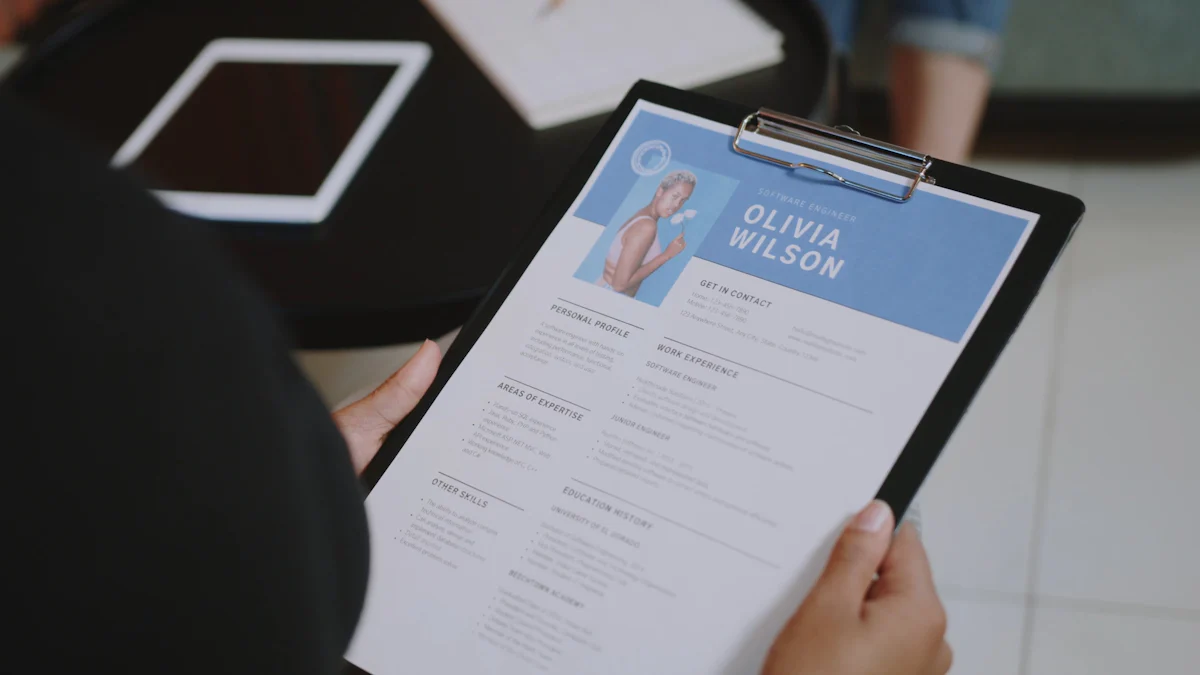How to Craft a Winning Full-Stack Software Engineer Resume in 2025
Try Aihirely for
Smarter Interview Prep
Experience real-time AI support tailored to your Resume.
Boost your confidence and ace every question with
AI Mock Interview.

Image Source: unsplash
A strong fullstack software engineer resume to get hired is your gateway to landing a full-stack software engineering role in 2025. Companies are actively seeking developers who can seamlessly manage front-end, back-end, and database tasks. Your resume must highlight these abilities while showcasing your expertise in emerging trends like cloud-native applications, AI integration, and microservices architecture. Including relevant keywords from job descriptions ensures your application stands out to recruiters and applicant tracking systems (ATS). A well-crafted resume not only demonstrates your technical skills but also positions you as a top candidate in a competitive market.
Key Takeaways
-
Show your tech skills clearly. Add front-end and back-end tools to prove you are a full-stack developer.
-
Use numbers to explain your success. Numbers help show how your work made a difference.
-
Change your resume for each job. Add words from the job post to match your skills with what the company wants. This helps with ATS systems.
-
Make your resume neat and simple. Use a timeline format, easy-to-read fonts, and short bullet points.
-
Add personal projects and certifications. These show you take initiative and keep learning.
Key Components of a Full-Stack Software Engineer Resume

Image Source: pexels
Personal Information
Formatting tips for contact details.
Your contact information is the first thing recruiters see, so make it clear and professional. Place your name at the top in a bold, slightly larger font. Below it, include your phone number, email address, and city of residence. Use a professional email address—avoid anything too casual or outdated.
Keep the formatting clean. For example:
John Doe
(123) 456-7890 | john.doe@email.com | San Francisco, CA
What to include and avoid (e.g., GitHub, LinkedIn, social media links).
Include links to your GitHub and LinkedIn profiles to showcase your work and professional network. If you have a portfolio website, add that too. Avoid personal social media accounts unless they are relevant to your career. Never include sensitive information like your full address or personal identifiers.
Resume Objective or Summary
Examples for entry-level engineers.
If you’re just starting, focus on your skills and enthusiasm. For example:
“An ambitious entry-level full stack developer skilled in front-end and back-end technologies, eager to build functional and scalable web applications. Proficient in HTML, CSS, JavaScript, and Node.js. Completed multiple projects through internships and self-learning platforms, demonstrating a passion for coding and problem-solving.”
Highlight any projects or internships that show your potential. Mention tools like HTML5, CSS3, or JavaScript frameworks to align with job requirements.
Examples for experienced professionals.
For experienced engineers, emphasize your achievements and technical expertise. Tailor your summary to the job. For instance:
“A seasoned full-stack software engineer with 7+ years of experience designing and implementing scalable web applications. Spearheaded the development of a cloud-native platform that improved system efficiency by 30%. Skilled in React, Node.js, and AWS, with a proven track record of delivering impactful solutions.”
Quantify your impact with metrics to make your resume stand out.
Professional Experience
Highlighting results and impact with action verbs.
Your experience section should tell a story of growth and impact. Start each bullet point with strong action verbs like “developed,” “launched,” or “implemented.” For example:
-
Developed a microservices-based architecture that reduced system downtime by 20%.
-
Spearheaded a team to deliver a new e-commerce platform, increasing sales by 15%.
These verbs grab attention and show your contributions clearly.
Quantifying achievements to demonstrate value.
Numbers make your achievements tangible. Instead of saying, “Improved application performance,” write, “Optimized application performance, reducing load time by 40%.” This approach shows recruiters the value you bring. Highlight how your work benefited the company, such as improving user satisfaction or streamlining processes.
Education
Relevant coursework, certifications, and academic projects
Your education section should highlight coursework, certifications, and projects that align with full-stack development. Include courses like “Web Development,” “Database Management,” or “Cloud Computing.” Certifications can set you apart by proving your expertise in critical areas. Consider adding:
-
AWS Certified Developer – Associate: Validates your cloud deployment skills.
-
Google Professional Cloud Architect: Demonstrates advanced cloud solution design.
-
Microsoft Certified: Azure Developer Associate: Proves proficiency in Azure cloud applications.
-
Certified Kubernetes Administrator (CKA): Highlights expertise in managing containerized environments.
-
ScrumMaster Certification (CSM): Shows your ability to manage agile projects effectively.
Academic projects also matter. Mention projects like building a RESTful API, creating a responsive e-commerce site, or developing a cloud-native application. These examples demonstrate your hands-on experience.
When to include GPA or omit it
Deciding whether to include your GPA depends on its strength. Follow these guidelines:
-
Include your GPA if it is above 3.5.
-
Omit it if it is below 3.0.
-
For GPAs between 3.0 and 3.2, consider the context. Many companies prioritize skills over GPA.
If your GPA is strong, it can reinforce your academic credibility. Otherwise, focus on showcasing your skills and achievements.
Skills
Technical skills for full-stack development
Employers in 2025 seek developers with a robust technical skill set. Highlight your proficiency in:
-
Front-End Technologies: HTML, CSS, JavaScript, React, Angular, Vue.js.
-
Back-End Frameworks: Node.js, Python, Ruby, Java.
-
Databases: MySQL, PostgreSQL, MongoDB.
-
Version Control: Git and GitHub for collaboration.
-
Cloud Platforms: AWS, Azure, Google Cloud.
-
UI/UX Principles: Designing user-friendly interfaces.
These skills demonstrate your ability to handle both front-end and back-end tasks effectively.
Soft skills that enhance collaboration and problem-solving
Technical expertise alone isn’t enough. Employers value soft skills that improve teamwork and adaptability. Focus on:
-
Communication: Articulate ideas clearly to align with team goals.
-
Problem-solving: Tackle complex challenges across the stack.
-
Adaptability: Learn new tools and respond to changes quickly.
-
Time Management: Meet deadlines without compromising quality.
-
Creativity: Develop innovative solutions for user needs.
These skills make you a well-rounded candidate who thrives in collaborative environments.
Optional Sections
Projects and portfolios to showcase your work
Your projects section can elevate your resume by demonstrating your practical skills. Include:
-
Work Projects: Highlight significant contributions at previous jobs.
-
Academic Projects: Showcase assignments like building a web app or database.
-
Personal Projects: Mention independent ventures, such as a portfolio website.
-
Volunteer Projects: Include community work that reflects your commitment.
-
Freelance Work: Show your ability to manage and execute tasks independently.
Tailor each project description to the job. Emphasize relevant skills and results. Use metrics to quantify your impact, such as “Increased app performance by 25%.”
References and additional information
References are optional but can strengthen your application. Include them only if requested. You can also add sections like “Conferences & Workshops” or “Professional Development” to highlight your engagement with the industry. For example:
| Optional Section | Description |
|---|---|
| Certifications | Relevant credentials like AWS Certified Developer or CKA. |
| Conferences & Workshops | Participation in events showcasing your industry involvement. |
| Personal Projects | Independent ventures that demonstrate your skills. |
These sections provide a complete picture of your qualifications and dedication to growth.
Tailoring Your Fullstack Software Engineer Resume to Get Hired in 2025
Using Keywords from Job Postings
Identifying and incorporating relevant keywords
Tailoring your resume to specific job postings is essential in 2025. Recruiters want to see that you understand the role and align with the company’s needs. Start by carefully analyzing the job description. Identify keywords that highlight required skills, tools, or qualifications. For example, if the posting emphasizes “React” or “Node.js,” ensure these terms appear in your skills or experience sections.
Customizing your resume shows that you’re a strong fit for the role. It also demonstrates your awareness of the company’s culture and values. Tailored resumes stand out in competitive markets, increasing your chances of landing an interview.
Optimizing your resume for ATS (Applicant Tracking Systems)
Most companies use ATS to filter resumes. To avoid rejection, optimize your resume for these systems. Follow these strategies:
-
Use simple bullet points to enhance clarity.
-
Keep your contact information in the body of the resume, not in headers or footers.
-
Maintain a clean format without unnecessary design elements.
-
Include a “Core Competencies” section to highlight relevant skills.
Finally, test your resume with ATS tools before submission. This ensures it passes the initial screening and reaches human recruiters.
Showcasing Career Progression
Highlighting promotions, leadership roles, and growth
Your resume should reflect your career growth. Highlight promotions, leadership roles, and increased responsibilities. For example, if you advanced from “Junior Developer” to “Senior Full Stack Developer,” emphasize this progression. Include details about mentoring junior developers or leading projects. This demonstrates your ability to take on more responsibility and adapt to challenges.
Structuring your experience to tell a compelling story
Structure your experience in reverse-chronological order. Start with your most recent role and work backward. For each position, include a brief description of your responsibilities. Focus on key accomplishments that align with the job you’re applying for.
To tell a compelling story, identify a theme that ties your roles together. For instance, highlight your expertise in building scalable applications or leading cross-functional teams. Tailor your story to the job, ensuring it aligns with the company’s goals. This approach makes your fullstack software engineer resume to get hired more impactful.
Best Practices for Layout and Readability

Image Source: unsplash
Choosing the Right Format
Reverse chronological format
The reverse chronological format is the most widely used and trusted resume structure. It lists your most recent experience first, making it easy for recruiters to see your current skills and achievements. Employers prefer this format because it’s familiar and straightforward. They can quickly skim through your work history without confusion.
This format also highlights your career progression effectively. If you’ve taken on increasing responsibilities or earned promotions, this structure showcases your growth clearly. Here’s a quick breakdown of its advantages:
| Advantage | Explanation |
|---|---|
| Familiarity to employers | This format is well-known and understood by employers, reducing confusion. |
| Ease of skimming | Employers often spend limited time on resumes; this format allows for quick assessments. |
| Clear demonstration of professional growth and increasing responsibility | It effectively showcases a candidate’s career progression and responsibilities over time. |
If you want to make a strong first impression, the reverse chronological format is your best bet.
Functional and hybrid formats
Functional and hybrid formats are alternatives that work in specific situations. A functional format focuses on skills rather than work history. It’s ideal if you’re switching careers or have gaps in your employment. By emphasizing your abilities, you can redirect attention to what you bring to the table.
The hybrid format combines elements of both functional and reverse chronological structures. It highlights your skills while still providing a timeline of your experience. This format works well if you have a mix of technical expertise and a solid work history. Choose the format that best aligns with your career story and goals.
Formatting Tips
Font choices, spacing, and section headers
Your resume’s design should be clean and professional. Use a standard font like Arial, Calibri, or Times New Roman. Keep the font size between 10 and 12 points for readability. Use bold headers to separate sections and guide the reader’s eye.
Spacing is crucial. Leave enough white space between sections to avoid clutter. A well-spaced resume looks polished and is easier to read. For example, use 1-inch margins and consistent line spacing throughout.
Keeping the resume concise and scannable
Recruiters spend only a few seconds on each resume. Make yours count by keeping it concise. Limit your resume to one page if you have less than 10 years of experience. Use bullet points to present information clearly.
Focus on the most relevant details. Avoid long paragraphs or unnecessary details. Instead, use action verbs and quantifiable achievements to grab attention. A scannable resume increases your chances of making it to the next stage.
Tip: Always proofread your resume. Even a small typo can leave a negative impression.
Crafting a strong fullstack software engineer resume to get hired in 2025 is your key to standing out in a competitive market. Focus on showcasing your technical skills, quantifying achievements, and tailoring your resume to each job. Customizing your application demonstrates your fit for the role and increases your chances of passing ATS filters. Highlight your most impactful projects and align your experience with job requirements. Take action today—refine your resume, emphasize your strengths, and position yourself as the ideal candidate. Your next opportunity is waiting!
FAQ
How long should my full-stack software engineer resume be?
Keep your resume to one page unless you have over 10 years of experience. Recruiters spend seconds scanning resumes, so focus on the most relevant details. Use concise bullet points to highlight your skills and achievements.
Should I include personal projects on my resume?
Yes! Personal projects showcase your initiative and technical skills. Highlight projects that align with the job description. For example, mention building a responsive web app or developing a RESTful API. Use metrics to quantify your impact, like “Improved app performance by 20%.”
How do I make my resume stand out to recruiters?
Tailor your resume to each job posting. Use keywords from the description and quantify your achievements. Include links to your GitHub or portfolio to demonstrate your work. A clean, professional layout also helps grab attention.
Tip: Test your resume with ATS tools to ensure it passes automated screenings.
Should I list all my technical skills?
Focus on skills relevant to the job. Include front-end, back-end, and database technologies like React, Node.js, and MongoDB. Avoid listing outdated or irrelevant tools. Group skills into categories for better readability.
Do I need a cover letter with my resume?
Yes, a cover letter complements your resume. Use it to explain why you’re the perfect fit for the role. Highlight specific achievements and show enthusiasm for the company. A personalized cover letter can set you apart from other candidates.
Note: Always address the hiring manager by name if possible.
